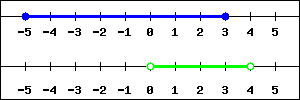Section 1.6 Exercises
These are the exercises in Module 1.
Checkpoint 1.6.1.
Checkpoint 1.6.2.
Simplify the following fraction.
\({{\frac{2}{3}}} + {{\frac{3}{4}}} \div {{\frac{5}{4}}} - {{\frac{2}{3}}}\)
\({}={}\)
Solution.
We must follow the order of operations when simplifying this expression. Begin by doing the division.
\(\displaystyle{\begin{aligned}[t]
{{\frac{2}{3}}} + {{\frac{3}{4}}} \div {{\frac{5}{4}}} - {{\frac{2}{3}}}\amp ={{\frac{2}{3}}} + {{\frac{3}{4}}} \cdot {{\frac{4}{5}}} - {{\frac{2}{3}}}\\
\amp ={{\frac{2}{3}}}+{{\frac{3}{5}}}-{{\frac{2}{3}}}\\
\amp = \frac{10}{15} + \frac{9}{15} - \frac{10}{15} \\
\amp = \frac{3}{5}
\end{aligned}
}\)
Checkpoint 1.6.3.
Divide one fraction into the other: \(\displaystyle{ \frac{7}{6} \div \left(-\frac{5}{4}\right) }\)
If needed, use an improper fraction in your answer. Don’t use a mixed number.
Solution.
When we do division with fractions, as with
\(\displaystyle{\frac{7}{6} \div \left(-\frac{5}{4}\right) }\)
we first change division to multiplication, and at the same time, flip the second fraction. In this case, we have
\(\displaystyle{\frac{7}{6} \cdot \left(-\frac{4}{5}\right) }\)
Then we do fraction multiplication as usual. The full process is:
\(\displaystyle{\begin{aligned}[t]
\frac{7}{6} \div \left(-\frac{5}{4}\right)
\amp = \frac{7}{6} \cdot \left(-\frac{4}{5}\right) \amp \hbox{We can divide the first denominator and the second numerator by 2.}\\
\amp = \frac{7}{3 }\cdot\left(-\frac{2}{5}\right) \\
\amp = -\frac{14}{15}
\end{aligned}
}\)
Checkpoint 1.6.4.
Subtract one fraction from the other: \(\displaystyle{\frac{9}{16} - \frac{15}{16}}\)
When needed, use an improper fraction in your answer. Don’t use a mixed number.
Solution.
To subtract two fractions with the same denominator, we simply subtract the numerators and keep the denominator unchanged.
\(\displaystyle{\begin{aligned}
\frac{9}{16} - \frac{15}{16}
\amp = \frac{9 - 15}{16} \\
\amp = \frac{-6}{16} \amp \hbox{We can reduce this by dividing 2 into both the numerator and the denominator.
}\\
\amp = -\frac{3}{8} \\
\end{aligned}
}\)
Checkpoint 1.6.5.
Evaluate this expression:
\(\displaystyle{ \left({{\frac{7}{4}}}-{{\frac{9}{20}}}\right)-5\left({{\frac{9}{20}}}-{{\frac{7}{4}}}\right)= }\)
Solution.
You might need to go back to previous units to review how to add fractions.
\(\begin{aligned}
\left({{\frac{7}{4}}}-{{\frac{9}{20}}}\right)-5\left({{\frac{9}{20}}}-{{\frac{7}{4}}}\right) \amp = {{\frac{13}{10}}} -5\left({{\frac{9}{20}}}-{{\frac{7}{4}}}\right) \\
\amp = {{\frac{13}{10}}} -5\left({-{\frac{13}{10}}}\right) \\
\amp = {{\frac{13}{10}}} -\left({-{\frac{13}{2}}}\right) \\
\amp = {{\frac{39}{5}}}
\end{aligned}\)
Checkpoint 1.6.6.
Evaluate this expression:
\(\displaystyle{ 8-2 [ 3-(6+5\cdot4)]= }\)
Solution.
The bracket [ ] and parentheses ( ) have the same purpose. We usually use [ ] when ( ) are already used in the problem, so we can tell which pair are which.
\(\displaystyle{\begin{aligned}[t]
\amp \phantom{={}} 8-2 [ 3-(6+5\cdot4)] \\
\amp = 8-2 [ 3-(6+20)] \\
\amp = 8-2 [ 3-26 ] \\
\amp = 8-2 [ -23 ]\\
\amp = 8 + 46 \\
\amp = {54}
\end{aligned}
}\)
Checkpoint 1.6.7.
Evaluate this expression:
\(2^4[2^5-2^3(2^1+2^4)] =\)
Checkpoint 1.6.8.
Checkpoint 1.6.9.
Checkpoint 1.6.10.
Checkpoint 1.6.11.
\(x =\)
Solution.
Use properties of exponents to simplify the left side of the equation\(\displaystyle{\begin{gathered} \frac{(2.8)^x (2.8)^{-3}}{(2.8)^{-6}} = (2.8)^{4} \\
(2.8)^x (2.8)^{-3} (2.8)^{ + 6} = (2.8)^{4} \\
(2.8)^{(x - 3 + 6)} = (2.8)^{4}\ . \end{gathered} }\) The two sides are equal if and only if the exponents are equal, so \(\displaystyle{ x - 3 + 6 = 4 }\text{.}\) Solving for \(x\) one obtains \(\displaystyle{ x = {1} }\text{.}\)
Checkpoint 1.6.12.
Checkpoint 1.6.13.
For each intersection or union, choose the correct notation for the resulting interval.
1. \((S \cup T)\)
2. \((S \cup W )\)
3. \((T \cap W)\)
4. \((S \cap T)\)
-
\(\displaystyle [-7, -1)\)
-
\(\displaystyle (-3, -1]\)
-
\(\displaystyle [-7, \infty)\)
-
\(\displaystyle (-\infty, \infty)\)
Checkpoint 1.6.14.
This exercise is concerned with operations with inequality and interval notations.
Match the sets and the inequalities by placing the letter of the inequality next to each set described below:
Checkpoint 1.6.15.
Sketch the following sets on a piece of paper and write them in interval notation. Enter the interval in the answer box. You may enter infinity for \(\infty\) and -infinity for \(-\infty\text{.}\) For example, you may write (-infinity, 5] for the interval \((-\infty,5]\text{.}\)
\({18 \le x \le 21}\) =
\({22 \lt x \le 27}\) =
\({-3 \lt x \lt 1}\) =
\({-4 \le x \lt 1}\) =
Checkpoint 1.6.16.
Checkpoint 1.6.17.
Checkpoint 1.6.18.

For the graphs shown above, find the following:
Answer:
Answer:



